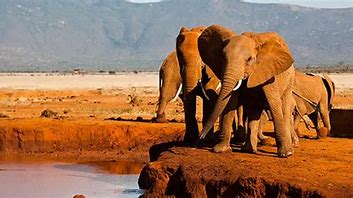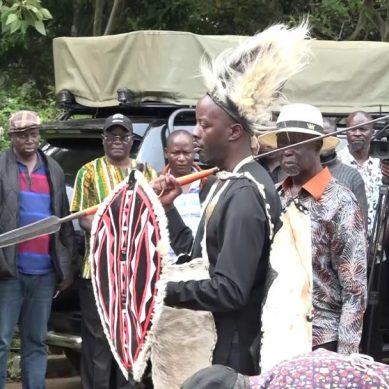
As a professional conservation biologist with immense grounding in ecology and environmental conservation and management, I am worried by the rapid spread southward advance of the Sahara Desert.
I have been worried by this advance since 1980 when I joined masters programme in the biology of conservation, which was offered in the Department of Zoology at Chiromo Campus of the University of Nairobi, Kenya. I became greatly concerned when I embarked on my research on vegetation changes in Tsavo East National Park, Kenya.
My interest was the interaction of Man (Homo sapiens), the African elephant, Loxodonta africana and wildfires in the vegetation dynamics in the Kenyan national park. I was motivated to do the research by the genocide of elephants around 1970 due to extreme temperatures and lack of adequate food and water.
In fact, the genocide of elephants occurred simultaneously with the genocide of vegetation species in the herb, shrub and tree layers of the park.
Fires – some wild, others deliberate – were a dominant phenomenon, which, apart from making survival of other species of wildlife, greatly affected the largest mammal on Earth –the elephant. While the dry woody vegetation in the park could not satisfy the energy needs of the elephants, the fires made it difficult for them to search for food and created large stretches of land devoid vegetation.
The long-distance communicating and moving animals would collapse and die because of thirst, hunger confounded by the very high temperatures. Corpses of elephants were far more distributed everywhere than vegetation.
That period of genocide of elephants was also distributed in the Sahel (Sahara Desert countries) and in parts of Ethiopia. The Sahara Desert was manifesting itself and jumping its boundaries, reaching Kenya farther south. Therefore, desertification was taking place.
In today’s environment-speak, climate change was taking place. We can say that desertification was taking place, consuming areas, which were not naturally desert. Tsavo National Park is a semi-desert area. The park was not only experiencing desertification but also extreme climate change seen in extreme temperatures.
One writer described desertification as a silent, invisible and slow-burn crisis that is currently destabilising livelihoods and communities in over 100 countries. Much like climate change, the impacts of desertification are felt first hand in specific belts of the world. That said, the rest of the world isn’t all immune to the risks, especially second-hand impacts such as social destabilisation, wars, migration, food security and water security.
Another writer recently wrote that climate change is one of the numerous things that are believed to speed up desertification. It is caused by the emission of greenhouse gases into the atmosphere, which have an impact on our environment. It is also one of the biggest environmental, socioeconomic, and political issues of our day.
Desertification has been described as “the greatest environmental challenge of our time” and climate change is making it worse. Although the process includes extreme temperature changes upwards, it is most seen physically in the recession of vegetation and in the genocide of species, collapse of ecosystems and cessation of some ecologies (ecocide) on the biocultural landscape. We refer to the process involving these phenomena as biological desertification. However, since it cannot occur apart from the land, it also includes the degradation of the land, not only belowground but also aboveground.
Thus, biological desertification, a form of land degradation, refers to the process where fertile or natural land transforms into arid desert due to a combination of natural factors and human activities, particularly the reduction or destruction of the land’s biological potential. This degradation results in the loss of biological productivity, including vegetation and can lead to soil erosion, reduced water infiltration, changes in the microclimate, species associations, species distributions and biodiversity.
Human activities in biological desertification might include fires; land-grabbing erasing agro-ecological farming systems; deforestation to establish monocultures of grasses such as sugarcane and oil palm or cereals such as rice, sorghum and millet or crops such as cotton, coffee and cocoa or to log; use of industrial fertilisers and pesticides and cultivation of genetically modified crops, which cannot thrive in association with other naturally occurring species of plants; polluting the land by introducing foreign substances such as plastics, nylon and others; urbanisation, including establishment of industrial parks; mining activities; waste dumping; and burial culture, including making coffins and concretising graves, to name but a few avenues of biological desertification.
Virtually, all these human activities are prevalent in Uganda. Therefore, biological desertification is entrenched in the country. Unfortunately, with the rise and rise presidentialism, wherein everything begins with the president of Uganda and ends with him; the rising culture of militarism, wherein the command-obey strategy of leadership and governance is eroding freedoms, justice and democracy, the environment in all its dimensions is not only the theatre but also the victim.
Biological desertification is not set to decrease but to proliferate mainly because of the policies, choices and strategies of building peace and security or governance. We have seen how the choices of the president in development have led to greater biological desertification in Kalangala District, Bugoma Forest Corridor and northern Uganda. The president’s silent endorsement of land-grabbing by people who belong to the nomadic pastoral energy system is responsible for the distortion of Uganda’s biocultural landscapes, which have sustained our food, ecological and environmental security for centuries.
Not all is lost. If we can have a new approach to peace and security, which de-emphasises militarism and military approach to peace and security and adopt ecological and environmental approach to peace and security in favour of ecological and environmental security, we shall contain biological desertification of Uganda.
I want to end this article by selling a new approach to re-greening our biocultural landscape and combat biological desertification. This approach is known as analogue forestry. It has been around for more than two decades but is hardly known in Uganda. A non-governmental organisation, the National Association of Professional Environmentalists (NAPE) tried to popularise it among certain communities, but did not go far because power at the local, district and national levels did not incorporate it in their strategies of ecological and environmental renewal.
Analogue Forestry is a system of ecological restoration that focuses on increasing biodiversity by imitating natural forest systems in order to create economically productive and environmentally mature forests. This methodology is based on traditional forest gardens, which are human-created analogues of the natural forest that serves needs such as food, fibre, timber, medicine and water. It increases the biodiversity and ecological resilience of a landscape by making use of natural ecological succession and forest functions, consequently strengthening rural livelihoods.
The idea of analogue forestry needs to be integrated in school and university curricula because superior to other methods of re-greening biocultural landscapes where natural forests were integral to the landscapes but have been receding because human activities. The method can also be used to restore our agro-ecological systems to enhance food security.
However, if nomadic pastoral people from elsewhere continue to have a field day on our biocultural landscapes, the method won’t be applicable and our agro-ecological farming systems will continue to disappear. This will be confounded by the ecologically and environmentally empty socioeconomic models such as Myooga, Operation Wealth Creation and Parish Development Model, which only focus on financial and economic gains of the beneficiaries at the expense of natural ecologies and environments.
For God and my country.
- A Tell report / By Oweyegha-Afunaduula / Environmental Historian and Conservationist Centre for – Critical Thinking and Alternative Analysis (CCTAA), Seeta, Mukono, Uganda.
About the Centre for Critical Thinking and Alternative Analysis (CCTAA)
The CCTAA was innovated by Hyuha Mukwanason, Oweyegha-Afunaduula and Mahir Balunywa in 2019 to the rising decline in the capacity of graduates in Uganda and beyond to engage in critical thinking and reason coherently besides excellence in academics and academic production. The three scholars were convinced that after academic achievement the world outside the ivory tower needed graduates that can think critically and reason coherently towards making society and the environment better for human gratification. They reasoned between themselves and reached the conclusion that disciplinary education did not only narrow the thinking and reasoning of those exposed to it but restricted the opportunity to excel in critical thinking and reasoning, which are the ultimate aim of education. They were dismayed by the truism that the products of disciplinary education find it difficult to tick outside the boundaries of their disciplines; that when they provide solutions to problems that do not recognise the artificial boundaries between knowledges, their solutions become the new problems. They decided that the answer was a new and different medium of learning and innovating, which they characterised as “The Centre for Critical Thinking and Alternative Analysis” (CCTAA).For God and my country.
Further reading
Bas Fransen (2020). Desertification: What it means and why it matters. EcoMatcher, 30 July 2020 https://www.ecomatcher.com/desertification-what-it-means-and-why-it-matters/ Visited on 21 May 2025 at 2052 pm EAT.
Daily Monitor (2021). Flirting with desertification. Daily Monitor, July 09 2021. https://www.monitor.co.ug/uganda/lifestyle/reviews-profiles/flirting-with-desertification-1520376 Visited on 21 May 2025 at 20:18 pm EAT.
Gregory S. Okin, Anthony J. Parsons, John Wainwright, Jeffrey E. Herrick, Brandon T. Bestelmeyer, Debra C. Peters, Ed L. Fredrickson, Do Changes in Connectivity Explain Desertification?, BioScience, Volume 59, Issue 3, March 2009, Pages 237–244, https://doi.org/10.1525/bio.2009.59.3.8 https://academic.oup.com/bioscience/article-abstract/59/3/237/333434?redirectedFrom=fulltext Visited on 21 May 2025 at 20:35 pm
Fekadu Hailu (2023). Climate change as a trigger for desertification and possible alternatives to reduce biodiversity loss. J. Selva Andina Biosph. vol.11 no.1 La Paz 2023 Epub 01-Mayo-2023 http://www.scielo.org.bo/scielo.php?script=sci_arttext&pid=S2308-38592023000100094 Visited on 21 May 2025 at 20:44 pm EAT
Sharma, I.P., Kanta, C., Chandra, S. (2024). Land Degradation and Desertification: Causes, Mechanism, and Biological Management. In: Mishra, G., Giri, K., Singh, S., Kumar, M. (eds) Sustainable Land Management in India. Springer, Singapore. https://doi.org/10.1007/978-981-97-5223-2_2https://link.springer.com/chapter/10.1007/978-981-97-5223-2_2#citeas Visited on 21 ay 2025 at 20:30 pm EAT.
Sujith Ravi, Paolo D’Odorico, Scott L. Collins, Travis E. Huxman (2009). Can Biological Invasions induce Desertification? The Phytologist, 15 January 2009. https://nph.onlinelibrary.wiley.com/doi/10.1111/j.1469-8137.2009.02736.x Visited on 21 May 2025 at 20:25 pm EAT.






